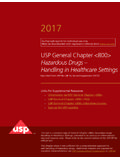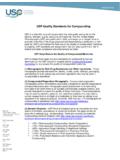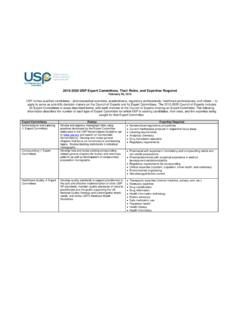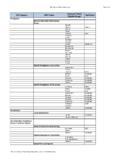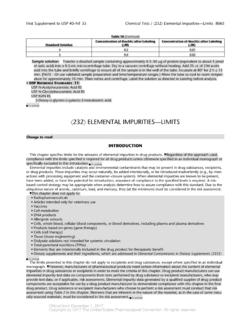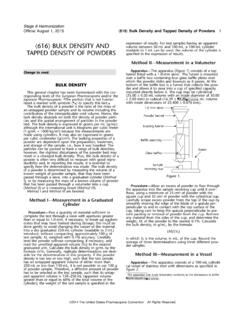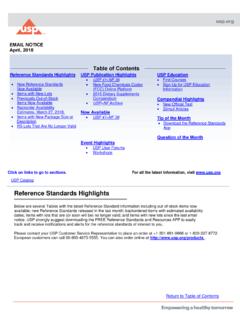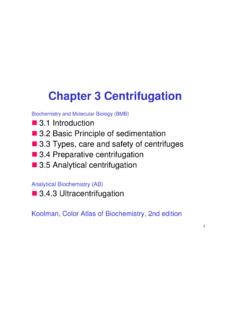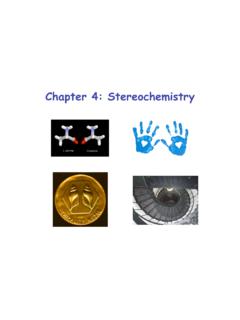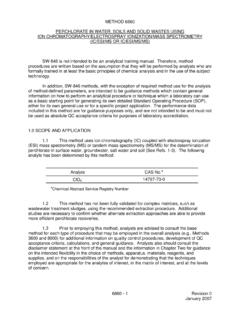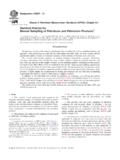Transcription of USP Guideline for Submitting Requests for Revision …
1 USP Guideline for Submitting Requests for Revision to USP NF Submission Guideline for Chemical Medicines Page 1 of 21 EFFECTIVE DATE 04/29/2016 TABLE OF CONTENTS A. INTRODUCTION 1. General Information 2. Submitting a Request for Revision Purpose General requirements and considerations 3. What to Expect After Submission Process Briefing Approximate timeline 4. Flexible Monographs Purpose Additional procedures Alternate acceptance criteria Labeling requirements B. MONOGRAPH CONTENT 1. Name Drug substance Drug product 2. Description (Chemical Information) Information to include Drug substance forms CAS number 3. Definition Drug substance Drug product 4. Identification Infrared spectroscopy Ultraviolet spectroscopy Liquid chromatography or gas chromatography Thin-layer chromatography Tests for salts and counter-ions Melting range USP Guideline for Submitting Requests for Revision to USP NF Submission Guideline for Chemical Medicines Page 2 of 21 EFFECTIVE DATE 04/29/2016 X-ray diffraction tests Other 5.
2 Assay General requirements LC procedures GC procedures Titration Other 6. Impurities Organic impurities Inorganic impurities Residual solvents 7. Performance Tests Dissolution <711> Uniformity of Dosage Units <905> 8. Specific Tests Optical Rotation <781> pH <791> Loss on Drying <731> and Water Determination <921> Tests to control microbial contamination Antimicrobial agent test Melting Range or Temperature <741> 9. Additional Requirements Packaging and storage Labeling Reference Standards C. OTHER INFORMATION 1. Reagents 2. Chromatographic Columns 3. Reference Tables: Description and Solubility D. CHECKLIST FOR Submitting Requests FOR Revision TO THE USP NF FOR NEW AND EXISTING CHEMICAL MEDICINES MONOGRAPHS USP Guideline for Submitting Requests for Revision to USP NF Submission Guideline for Chemical Medicines Page 3 of 21 EFFECTIVE DATE 04/29/2016A.
3 INTRODUCTION 1. General Information Sponsors should be familiar with the General Information for All Submissions at the beginning of this Guideline . Sponsors also should be familiar with the General Notices and Requirements (General Notices) to USP NF, which provide the basic assumptions, definitions, and default conditions for the interpretation and application of USP NF standards. Submissions under this Guideline should also conform to general chapters <1> to <5> of USP NF, as applicable, which reflect USP's current expectations for monograph specifications for various dosage forms. References to other relevant general chapters in USP NF are provided by title and chapter number throughout this document as needed. 2. Submitting a Request for Revision Purpose. The purpose of a Request for Revision (RFR) generally is: To create a new monograph for a new drug substance or drug product To revise or update an existing monograph.
4 Note that every Revision must be meaningful, add value, and contribute to the public standard. General requirements and considerations Follow the attached Checklist for Submitting Requests for Revision to the USP NF for New and Existing Chemical Medicines Monographs. Specify the FDA approval status. For monograph submissions from sponsors whose applications are pending FDA approval, please see the Pending Monograph Guideline . Consider the consistency of impurity limits and chemical names for monograph families. USP is actively engaged in efforts to bring up to date official USP NF monographs that utilize outdated technology, have safety, environmental concerns, or are missing procedures for key aspects such as impurities. USP Guideline for Submitting Requests for Revision to USP NF Submission Guideline for Chemical Medicines Page 4 of 21 EFFECTIVE DATE 04/29/2016 Introduction of new techniques will be considered on a case-by-case basis.
5 It is preferable to start with the development of a general chapter describing the technique before referencing the technique in a monograph. Please contact the liaison(s) responsible for general chapter development to suggest a new chapter. 3. What to Expect After Submission Process. Each submission is assigned to a scientific liaison to assist with scientific, compendial and regulatory issues pertaining to the submission. The assigned scientific liaison will assist the sponsor with any questions throughout the entire standard-setting processes. The scientific liaison reviews the submission, creates a draft in USP NF style with the appropriate Briefing, and sends the draft to the sponsor along with a list of the liaison s questions and comments. The draft undergoes several reviews including review and recommendations by the corresponding Expert Committee. Once finalized, the proposal will be published in Pharmacopeial Forum (PF) for public comment.
6 Following the comment period, the proposal and comments received will be reviewed by the relevant Expert Committee, which is responsible for approving the Revision . Briefing. A Briefing will accompany the Revision when published in PF for comment, and typically includes the following information: Background and rationale for the Revision Source (if adopted from other compendia or based on information available in public domain) Important auxiliary information that is not included in the official text, such as brand names of high-performance liquid chromatography (HPLC) columns used to validate the method, and typical retention times Deadline for submission of public comments USP Guideline for Submitting Requests for Revision to USP NF Submission Guideline for Chemical Medicines Page 5 of 21 EFFECTIVE DATE 04/29/2016 Other information that the Expert Committee wants to convey to the readers, such as delayed implementation, request for additional supporting information, etc.
7 The abbreviated name of the Expert Committee and the name of the scientific liaison Approximate timeline. It typically takes 18 24 months from receipt of a submission until the Revision becomes official. The process may take longer, depending on the completeness of the submission, availability of the Reference Standard (RS; see section B. Reference Standards below), and timeliness of the sponsor s response to questions and comments. 4. Flexible Monographs Purpose. Flexible monographs provide an important means of compliance for official substances and official products (defined in General Notices Official Articles) that are available in the marketplace. For example, official substances may be produced by different synthetic routes or manufacturing processes, and official products may have different formulations and different forms of official substances. The flexible monograph approach is used when subsequent submissions provide documented evidence that the original monograph does not cover the official substances and official products covered by these submissions.
8 Additional procedures. The flexible monograph approach is not provided as a mechanism for publishing multiple procedures that generate equivalent results for the same test. The sponsor is expected to demonstrate that the additional procedure is justified by a true technical need, is not simply for convenience, and will add value to the monograph. Alternate acceptance criteria. Alternate acceptance criteria included in a flexible monograph must be those approved by FDA, and they must have no adverse effect on product quality. Alternate acceptance criteria pending final FDA approval should be considered for publication as per the Pending Monograph Guideline , to be incorporated into the official monograph upon FDA approval. USP Guideline for Submitting Requests for Revision to USP NF Submission Guideline for Chemical Medicines Page 6 of 21 EFFECTIVE DATE 04/29/2016 Labeling requirements. When a new test, procedure, or acceptance criterion is added to an existing monograph using a flexible monograph approach, a Labeling section is added to the monograph.
9 The Labeling section requires that the article be labeled to indicate that the alternative test, procedure, or acceptance criterion is applicable. See General Notices Applicability of Test Procedures. B. MONOGRAPH CONTENT 1. Name The names (titles) for drug substances and drug products are approved by USP s Nomenclature and Labeling Expert Committee. Drug substance. The name is usually designated using the United States Adopted Name (USAN), as outlined in Nomenclature <1121> and in USP NF Front Matter, Mission and Preface, Legal Recognition. Drug product. See General Chapter <1121> for general principles on naming of dosage forms. 2. Description (Chemical Information) This section refers to the drug substance only. Also see the Reference Tables, Description and Solubility section of USP NF, General Notices Description and Solubility and section C. 3 Reference Tables: Description and Solubility, below. Information to include.
10 This section of the monograph consists of the structure (if available), molecular formula, molecular weight, Chemical Abstracts Service (CAS) registry number (American Chemical Society), and chemical name(s). For more information, see USP NF Front Matter, Mission and Preface, Chemical Names and CAS Registry Numbers. Drug substance forms. The same USP NF monograph can be used to address different hydrates/polymorphs under the flexible monograph approach described above, but different monographs are required for salts as compared with a free base/acid and for different salts. USP Guideline for Submitting Requests for Revision to USP NF Submission Guideline for Chemical Medicines Page 7 of 21 EFFECTIVE DATE 04/29 CAS number. Where more than one CAS number has been used to describe the molecule, all numbers must be included. For example, different CAS numbers may exist for different hydrates or polymorphs. 3. Definition The Definition section contains the acceptance criteria for the Assay and may contain other information as indicated below.
